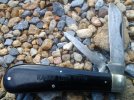Many thanks for the thread Carl :thumbup: That Lambcliffe is pretty close isn't it P?
There are of course many ways in which our nations differ culturally, but one difference is in respect of hunting, and particularly the hunting of large game. Historically, what little large game we have here, belonged to the King and his cohorts, (even now that hasn't changed much), and a man would be executed for killing a deer for example. The North of England suffered enforced deforestation under William 1, the Norman conqueror, which must have further reduced the numbers of large game. Much later, industrialization spread rapidly, along with urbanisation, most of this country's population live in town's and cities, cut off from the woods and moors. Even today, hunting is a minority pursuit here, and mostly the preserve of the gentry.
While Sheepsfoot and Lambsfoot knives are traditionally farmer's knives, even the farmer would have made relatively little use of a hunting knife - of a knife with some belly. The Lambsfoot was a pattern carried by men in the towns and cities, who would rarely even come into contact with a rabbit, let alone a stag.
In the US, of course, things are very different, there's an amazing assortment of wildlife, and hunting for the pot, (unlike for sport, among the toffs here), was how many people fed themselves. While there are of course many huge cities, the country is nothing like as densely populated as the UK, and hunting is a mainstream blue-collar activity, unlike here. So people would have need of different sorts of blades, spears and clip-points, which would be more practical for dealing with a kill.
This is a tentative hypothesis I just thought up!

Of course it still doesn't explain a lot of things, such as why the Wharncliffe and Sheepsfoot are seen in the US, but not the Lambsfoot, or why the pattern never took hold in San Francisco or New York, like it did in London or Sheffield, but to a large extent, irrespective of other factors, people carry what they're used to, and what their dad and grandad did.
Just a few thoughts anyway

Jack







